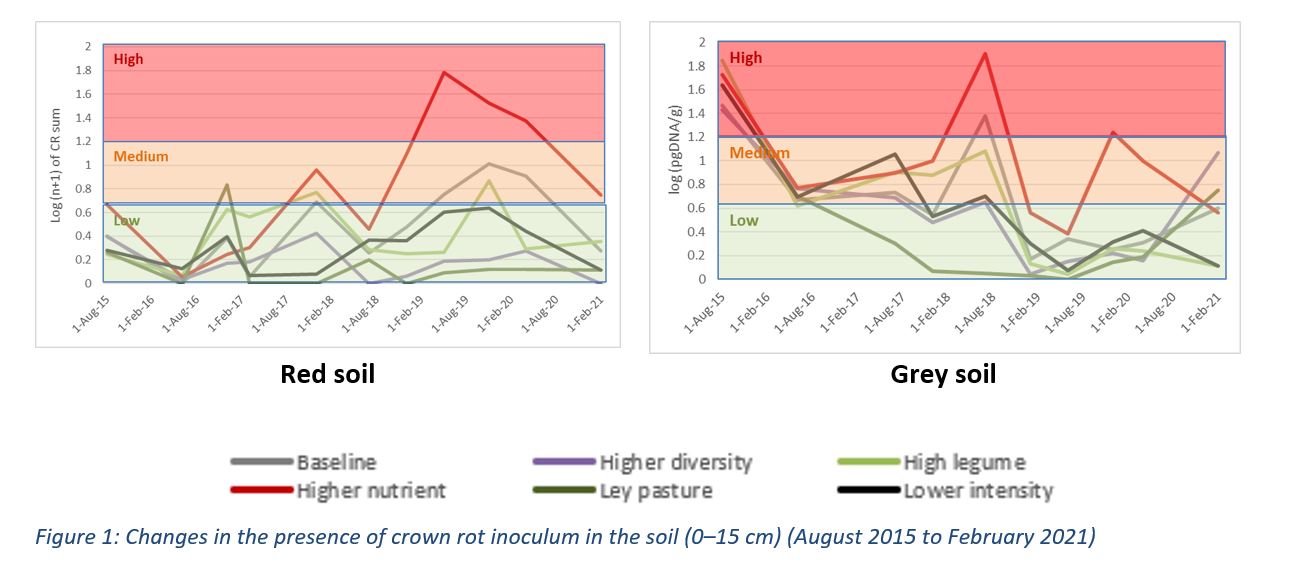Farming system effects on crown rot
Article supplied by Trangie Research Centre, May 2021
Crown rot is a major disease affecting cereal crops in NSW and has been known to cause significant yield losses, particularly in seasons where favourable conditions early in the crop season are followed by a dry finish.
The fungus survives on cereal stubble and grass weeds and is passed onto susceptible hosts. Managing crown rot involves a combination of variety selection, break crops and good crop management.
Crown rot and soil types
Figure 1 shows changes in the presence of crown rot over six years in six farming systems being investigated at Trangie. In 2015, all farming systems on the Red soil rated crown rot levels as ‘Low’. In contrast, initial crown rot levels were rated ‘High’ on the Grey soil at the same time. In the following years, the effects of farming systems have shown significant differences in crown rot levels and trends from one year to the next.
Figure 1: Changes in the presence of crown rot inoculum in the soil (0–15 cm) (August 2015 to February 2021)
The Baseline and Higher nutrient systems mirror each other regarding crop types (Figure 2), the only difference being greater nitrogen (N) applications in the latter system that target a 90th percentile season (compared with a 50th percentile season in the Baseline system). On both soil types, the additional N in the Higher nutrient system caused a rapid build-up of crown rot inoculum to ‘High’ levels, particularly in 2018 after two successive wheat crops. This increase is attributed to the larger bulky (high biomass) crop that was grown, compared with the Baseline system. The pattern of changes generally tracks the Baseline system when identical crop types are grown.
The Ley pasture demonstrated the effects of maintaining host-free conditions for the crown rot fungus over several years. On the Grey soil, crown rot levels increased to the ‘Medium’ category after just one wheat crop in 2020. In the Higher diversity system where back-to-back legume crops were grown in 2017 and 2018, subsequent crown rot levels progressively decreased on both soil types.
Seasonal conditions
The presence of a suitable host is just one part of the story. Seasonal conditions also play an important role. The dry winter crop season in 2019 resulted in the whole of the Grey soil site being fallowed for the winter crop season. The dry weather meant there was minimal decomposition of the 2018 crop residues during 2019, resulting in little change in crown rot levels in all farming systems between the 2018 harvest and the sowing in 2020.
On both soil types, the Lower intensity system was notable for the consistent low levels of crown rot, regardless of seasonal conditions and crop choice. On the Grey soil, despite the presence of initially high inoculum levels in 2015, the amount of inoculum has been consistently in the ‘Low’ category since 2018.
Inoculum
It is important to remember; the presence of crown rot gives an indication of the risk and potential magnitude of yield losses. The presence of inoculum does not always translate into high crop losses. A wet finish to the season can reduce the damage caused by crown rot but will not prevent yield losses in all cases.
The key to managing crown rot is to focus on the rotation and reduce inoculum. Remember, increasing inoculum = increased yield loss.
Figure 2: Farming Systems crop sequences on Red and Grey soil (2016–2020)
Symptoms
Symptom 1: Tiller bases always brown, often extending up 2–4 nodes (Image source S Simpfendorfer – NSW DPI).

Symptom 2: Scattered white heads (Image source S Simpfendorfer – NSW DPI).

Like to know more?
Find crop yield results at: (Trangie-Farming-Systems-research-write-up_March-newsletter.pdf (nsw.gov.au)).
Find soil nitrogen results at: 210329-Farming-system-effects-on-soil-nitrogen.pdf (nsw.gov.au)
For further information, contact:
Kathi Hertel M. 0427 104 344; E. kathi.hertel@dpi.nsw.gov.au
Greg Brooke M. 0437 140 577; E. greg.brooke@dpi.nsw.gov.au

